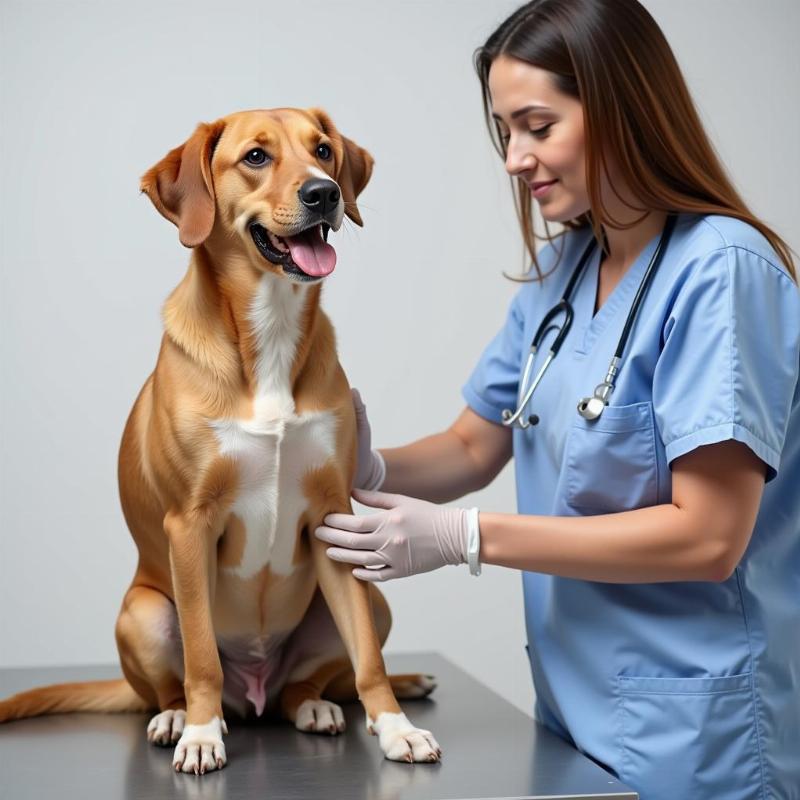Dog back left leg shaking can be a worrying sign for any pet owner. This trembling can range from a subtle quiver to violent shaking and can be caused by a variety of reasons, from simple muscle fatigue to more serious underlying conditions. Understanding the potential causes, how vets diagnose the problem, and the available treatment options is crucial for ensuring your furry friend’s well-being.
Why is My Dog’s Back Left Leg Shaking?
Several factors can contribute to a dog’s back left leg shaking. Is your dog shaking after a long walk or strenuous play session? This could simply be muscle fatigue or a minor strain. However, persistent or worsening tremors can indicate a more serious issue. Some common causes include:
- Injury: A sprain, strain, or fracture can cause pain and instability, leading to shaking. Trauma to the leg, such as being hit by a car, can also result in shaking.
- Arthritis: This degenerative joint disease is common in older dogs and can cause pain, stiffness, and inflammation, leading to trembling in the affected leg.
- Neurological Issues: Conditions like degenerative myelopathy, intervertebral disc disease (IVDD), or even a pinched nerve can disrupt nerve signals and cause muscle weakness and shaking.
- Dislocated Kneecap (Patellar Luxation): This condition, common in smaller breeds, occurs when the kneecap slips out of its normal groove, resulting in pain and instability.
- Infections: Infections in the leg or paw can cause inflammation and pain, leading to trembling.
Diagnosing the Shake: What to Expect at the Vet
If your dog’s back left leg shaking persists, it’s essential to consult a veterinarian. They will conduct a thorough physical examination, observing your dog’s gait and palpating the leg to check for pain, swelling, or instability. They might also ask about your dog’s history, including any recent injuries or changes in activity levels.
Depending on their initial assessment, your vet may recommend further diagnostic tests, such as:
- X-rays: To identify fractures, dislocations, or signs of arthritis.
- Blood tests: To rule out infections or metabolic disorders.
- MRI or CT scan: For a more detailed view of the bones, joints, and surrounding tissues, particularly in cases of suspected neurological issues.
 Veterinarian Examining a Dog's Leg
Veterinarian Examining a Dog's Leg
Treatment Options for a Shaking Leg
The treatment for a shaking back left leg will depend on the underlying cause. Some possible treatment options include:
- Pain medication: To manage pain and discomfort associated with injuries, arthritis, or infections.
- Anti-inflammatory drugs: To reduce inflammation and swelling.
- Physical therapy: To improve muscle strength, flexibility, and range of motion.
- Surgery: In cases of severe injuries, such as fractures or dislocations, or for conditions like IVDD or patellar luxation.
- Supplements: Such as glucosamine and chondroitin, to support joint health in dogs with arthritis.
When to Seek Immediate Veterinary Attention
While not all cases of leg shaking warrant immediate attention, some signs indicate a more urgent need for veterinary care:
- Sudden onset of severe shaking: This could indicate a serious injury or neurological problem.
- Inability to bear weight on the leg: This suggests significant pain or instability.
- Swelling, redness, or heat in the leg: These are signs of infection or inflammation.
- Vocalization or other signs of distress: Your dog might whine, yelp, or show other signs of discomfort.
Conclusion
A shaking back left leg in your dog can stem from various causes, ranging from simple muscle fatigue to more serious conditions like arthritis or neurological issues. Prompt veterinary attention is crucial for accurate diagnosis and appropriate treatment to ensure your dog’s comfort and well-being. Don’t hesitate to contact your vet if you notice persistent or worsening tremors in your furry friend’s leg.
FAQ
- My dog’s back left leg is shaking only after exercise. Is this normal? Occasional shaking after strenuous activity can be due to muscle fatigue. However, if it’s frequent or severe, consult your vet.
- Can a shaking leg be a sign of a serious problem? Yes, it can be a symptom of conditions like arthritis, neurological disorders, or injuries.
- What should I do if my dog’s leg is shaking and they can’t walk on it? Seek immediate veterinary attention. This could be a sign of a severe injury.
- Are there any home remedies for a shaking leg? It’s essential to consult your vet before trying any home remedies. An incorrect diagnosis can delay proper treatment.
- How can I prevent my dog’s leg from shaking? Maintaining a healthy weight, providing regular exercise, and supporting joint health with supplements can help prevent some causes of leg shaking.
Related Articles on Beautdogs.us
Beautdogs.us is your premier destination for all things dog-related in the US. We offer expert advice on dog breeds, grooming, nutrition, and healthcare. From puppy training tips to senior dog care, Beautdogs.us is your trusted source for comprehensive and engaging information to help you navigate the joys and challenges of dog ownership. Whether you’re a seasoned dog parent or a first-time owner, we’re here to support you every step of the way. Contact us today for personalized guidance! Email: [email protected], Phone: +1 501-555-7529 or visit Beautdogs.us.